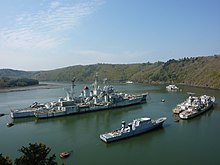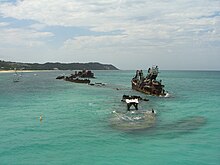






A ship graveyard, ship cemetery or breaking yard is a location where the hulls of scrapped ships are left to decay and disintegrate, or left in reserve. Such a practice is now less common due to waste regulations and so some dry docks where ships are broken (to recycle their metal and remove dangerous materials like asbestos) are also known as ship graveyards.
By analogy, the phrase can also refer to an area with many shipwrecks which have not been removed by human agency, instead being left to disintegrate naturally. These can form in places where navigation is difficult or dangerous (such as the Seven Stones, off Cornwall, or Blackpool, on the Irish Sea); or where many ships have been deliberately scuttled together (as with the German High Seas Fleet at Scapa Flow); or where many ships have been sunk in battle (such as Ironbottom Sound, in the Pacific).
The majority of the ships in the world are constructed in the developed countries. Ships last about 25–30 years, after which they become too expensive to maintain and are sold to be broken down. Most of them are directly sold to the ship recycling companies in India, Bangladesh, Pakistan and other developing countries, also known as the (semi-)periphery countries from Immanuel Wallerstein's World System Theory. In 2014, 54 percent of the ships went to the beaches of India and Bangladesh. This is consistent with the period 2012–2018. From the total of 6,702 scrapped ships worldwide, 3,586 ships have been scrapped in India and Bangladesh, which comes down to 53.5 percent.
As of January 2020, with 30% share India has the highest global revenue and highest share of global ship breaking (number and volume of ships broken).
It is estimated that ship breaking yards provide more than 100,000 jobs to people worldwide and that they yield millions of tons of steel every year with a minimal consumption of electricity. Besides steel, this industry also yields a huge amount of solid wastes in the form of scrapped wood, plastic, insulation material, glass wool, sponge, waste paper, oiled rope and cotton waste.
List of ship graveyards
Africa
See also: List of shipwrecks of Africa- Wrecks all along the peninsular coast at Nouadhibou, in Mauritania
- Many wrecks along the Skeleton Coast in Namibia
Asia
See also: List of shipwrecks of Asia- Several locations near the Aral Sea
- The ship-breaking yards of Alang (India), Chittagong (Bangladesh), and Gadani (Pakistan)
Europe
France
- Guilvinec-Lechiagat
- On the River Rance
- Magouër (Plouhinec, Morbihan)
- Plouhinec, Finistère
- Landévennec
Sweden
United Kingdom
- The River Tamar downstream of the Royal Albert Bridge used to be used as a mooring site for mothballed vessels, including submarines, of the Royal Navy. These have now all been removed.
- Portsmouth Harbour hosts a number of ex Royal Navy vessels, awaiting removal for scrapping.
- Forton Lake in Gosport, near Portsmouth, is host to approximately thirty vessels, several of which saw action in World War II.
- Scapa Flow, where in 1919 German sailors sank their own fleet while interned. Most of the ships were excavated in the following years, but there are still 8 wrecks from this event and several others.
North America
United States
See also: List of shipwrecks of the United States- The US Navy "phantom fleet" at Suisun Bay, to the north of San Francisco Bay
- The US Army Patuxent River "ghost fleet" of 1927–40, comprising the USAT Monticello (ex-USS Agamemnon, ex-German SS Kaiser Wilhelm II of 1903), America (ex-German SS Amerika of 1905), Mount Vernon (ex-German Kronprinzessin Cecile of 1907) and George Washington (ex-German SS George Washington of 1909)
- Witte's Marine Salvage - the Staten Island boat graveyard.
- Bikini Atoll was designated as a ship graveyard for the U.S. Pacific fleet; it later became known as a nuclear testing facility.
- Mallows Bay, Maryland.
- Green Jacket Shoal, Rhode Island
Oceania
Australia
See also: List of shipwrecks of Australia and Australasian Underwater Cultural Heritage Database- Stockton Breakwater (Newcastle)
- Homebush Bay Ships' Graveyard (Sydney)
- Pindimar Bay Ships' Graveyard/The Duckhole (Myall Lakes)
- Darwin Harbour East Arm
- Bishop Island Ships' Graveyard (Brisbane)
- Tangalooma Wrecks (Moreton Island)
- The Bulwer Wrecks (Moreton Island)
- Curtin Artificial Reef
South Australia: As of November 2020 there are 19 ships' graveyards in South Australia.
- Near Port Adelaide, in the Port River and environs:
- Others
- Ardrossan (the No 5 dumb hopper barge)
- Cowell
- Glenelg
- Goat Island
- Kangaroo Island
- Port Augusta
- Port Flinders
- Port Lincoln
- Port Noarlunga
- Port Pirie
- Port Stanvac
- Stenhouse Bay
- Whyalla
- Yankalilla Bay (HMAS Hobart)
- Little Betsey Island Ships' Graveyard (Hobart)
- East Risdon Ships' Graveyard (Hobart)
- Strahan Ships' Graveyard (Strahan)
- Tamar Island Ships' Graveyard (Launceston)
- Barwon Heads Ships' Graveyard (Port Phillip Bay)
- Careening Bay Ships' Graveyard
- Rottnest Island Ships' Graveyard (off Rottnest Island)
- Jervoise Bay Ships' Graveyard
- Albany Ships' Graveyard (Albany)
See also
- Aircraft boneyard
- Ghost ship
- Derelict (maritime)
- Marine debris
- Marine pollution
- Shipbreaking
- Train graveyard
References
- IndustriALL. (2015, 15 december). SPECIAL REPORT: Cleaning up shipbreaking the world’s most dangerous job.
- Buchholz, K. (2019, 13 maart). India and Bangladesh Are Scrapping Bulk of Old Ships. Statista Infographics. Retrieved December 5, 2021, from
- India eyes 60 per cent share of global ship recycling business; higher GDP contribution, Economic Times, 30 December 2019.
- YPSA. (n.d.). Overview of Ship Breaking in Bangladesh. Ship Breaking in Bangladesh.
- Srinivasa Reddy, M., Basha, S., Sravan Kumar, V., Joshi, H., & Ghosh, P. (2003). Quantification and classification of ship scrapping waste at Alang–Sosiya, India. Marine Pollution Bulletin, 46(12), 1609–1614.
- Gadani Beach
- Cairis, Nicholas T. (1979), Passenger Liners of the World Since 1893, Revised Edition, pp. 152, 155, 159, 206, 208. New York: Bonanza Books. ISBN 0-517-28875-3
- Neill, Peter (1988), Maritime America: Art and Artifacts From America's Great Nautical Collections, pp. 135, 146-147. New York: Balsam Press, Inc.
- "Staten Island Boat Graveyard".
- United States Coast Pilot. Vol. 3 (43rd ed.). Washington, D.C.: National Ocean Service. 2010. p. 313. Retrieved May 5, 2010.
- "Ships' graveyards of South Australia". Government of South Australia. Department for Environment and Water. Retrieved 22 November 2020.
- "Port Adelaide (Ships' Graveyards)". South Australian Department of Environment and Heritage. Retrieved 12 June 2012.
- Hartell, Robyn; Richards, Nathan (2001). Garden Island, Ships's Graveyard. Heritage SA, Department for Environment and Heritage. pp. 1–6. ISBN 0-7308-5894-4.
- Richards, Nathan (1997). The History and Archaeology of the Garden Island Ships' Graveyard, North Arm of the Port River, Port Adelaide, South Australia (PDF) (BA(Hons) thesis, Archaeology)). Flinders University. pp. 26–30. Archived from the original (PDF) on 4 March 2016. Retrieved 13 June 2012.
- (in French) Ship graveyards
- (in French) Ship graveyard on the Rance
- (in French) Ship graveyard at the port of Guilvinec-Lechiagat
- (in French) Ship graveyard at Magouër Archived 2009-04-28 at the Wayback Machine
- Google maps view of ships graveyard
| Vehicle graveyard | |
|---|---|